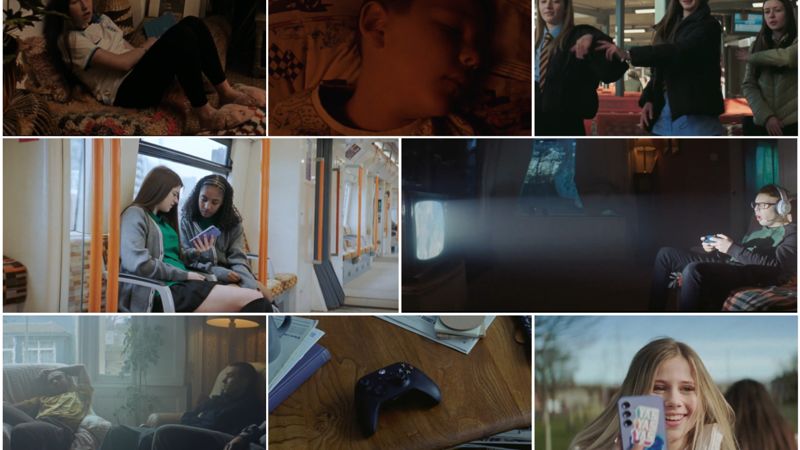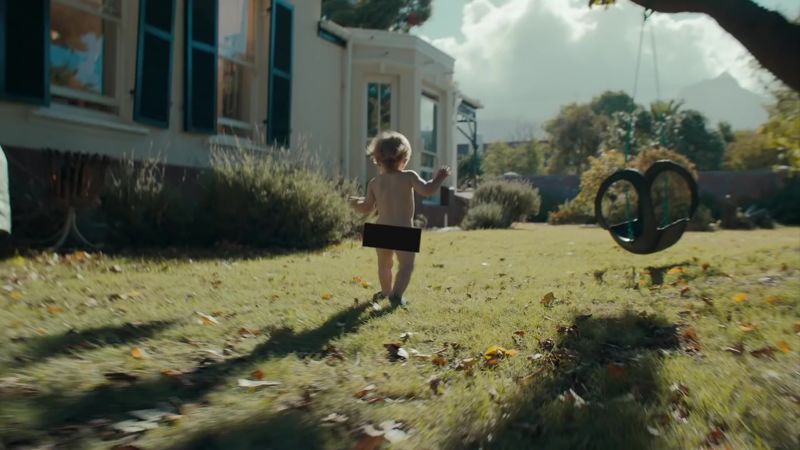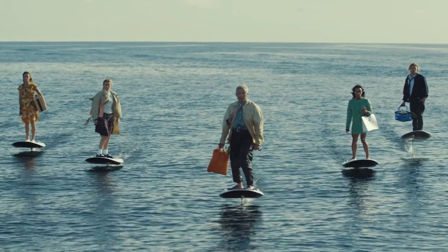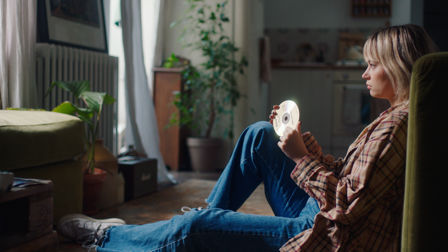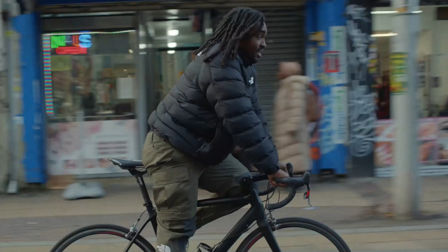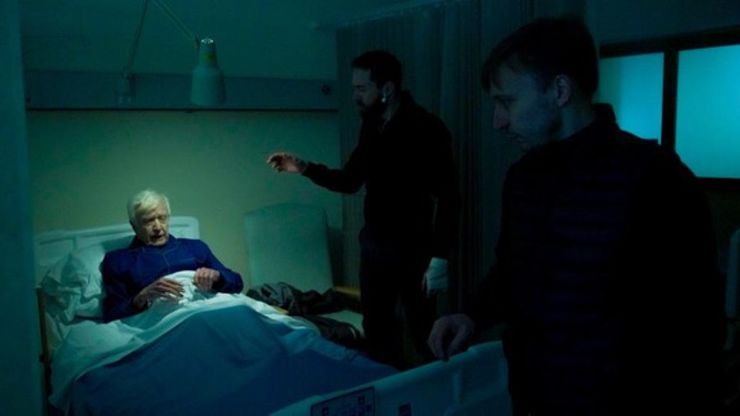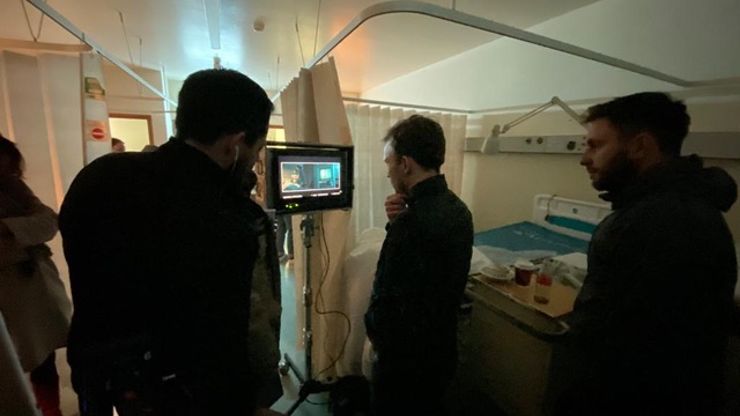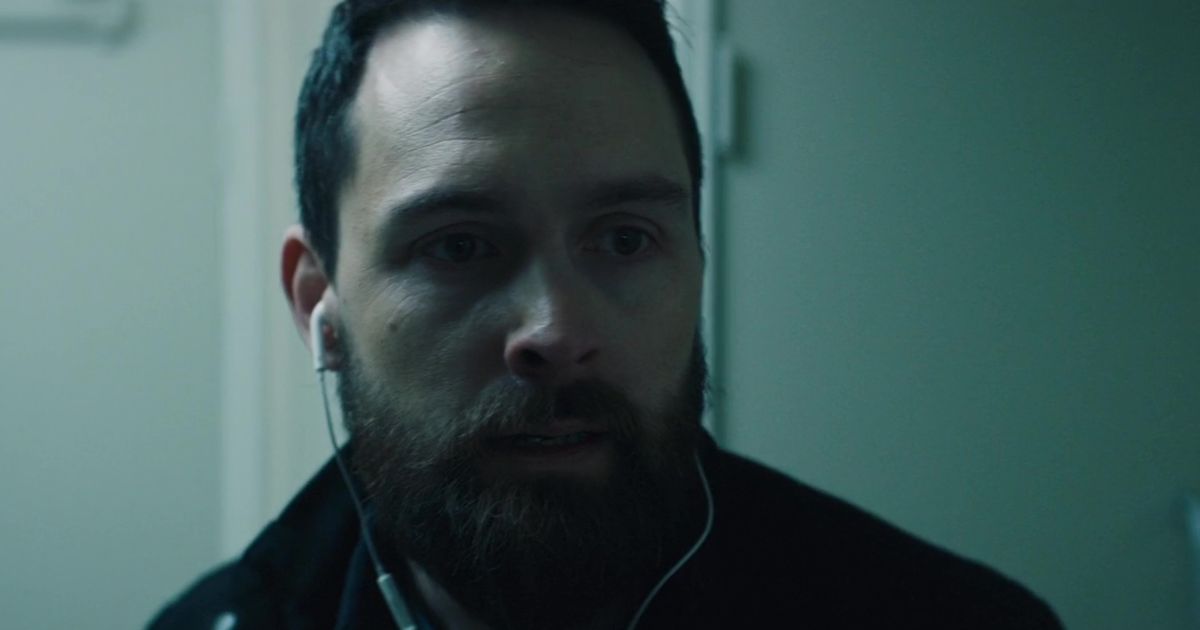How Neil Linpow learnt his lesson
We chat to the Partizan EP about his self-directed/performed dramatic short Lesson 7, which sees self-help guidance take a dark path.
We've all needed a bit of guidance throughout the past year, but hopefully none as extreme as the advice followed by Ash, the conflicted protagonist of Neil Linpow's latest short.
Tightly shot and centred around an intriguing premise - how far do we go in the pursuit of self-help - Lesson 7 is another punchy directorial showcase for the Partizan EP (who, just to add another feather to his cap, also stars).
Featuring the voice of Game Of Thrones' Michelle Fairley as the untrustworthy mentor and making great use of its claustrophobic setting, the film intrigued us, so we caught up with Linpow to find out what lessons were learnt.
Credits
powered by
-
- Production Company Big Trouble Films
- Director Neil Linpow
-
-
Unlock full credits and more with a Source + shots membership.
Credits
powered by
- Production Company Big Trouble Films
- Director Neil Linpow
- Colorist Toby Tomkins
- Post Producer Dionne Archibald
- Executive Producer Colm McCarthy
- DP Job Reineke
- Editor Elena De Palma
- Post Production Producer Jason Oakley
- Sound Factory
- Sound Producer Lucy Spong
- Sound Producer Beth Massey
- Post Producer Ray Okudzeto

Credits
powered by
- Production Company Big Trouble Films
- Director Neil Linpow
- Colorist Toby Tomkins
- Post Producer Dionne Archibald
- Executive Producer Colm McCarthy
- DP Job Reineke
- Editor Elena De Palma
- Post Production Producer Jason Oakley
- Sound Factory
- Sound Producer Lucy Spong
- Sound Producer Beth Massey
- Post Producer Ray Okudzeto
Where did the idea of the short come from? Please don't say it's based on a true story...
I hope it’s not! Writer Hunter Andrews and I had been kicking around a feature idea about a ten-step self-help program that preyed on vulnerable people for a while. We thought an interesting approach initially would be to make a proof of concept that also worked as a short film in its own right.
We trust the apps we download, the audiobooks, podcasts and life guides we listen to. We wondered what it might look like if someone was able to abuse that trust.
These days we’re all so reliant on creating shortcuts and life hacks. So much of what we do and what we trust is digital and anonymous. Our phones have become our most trusted confidants. We let it into our psyche and desires. We trust the apps we download, the audiobooks, podcasts and life guides we listen to. It’s the place we look to find the answers to both our passing whims and our deeper more existential life questions. We wondered what it might look like if someone was able to abuse that trust. Just how malleable could a vulnerable person’s identity be, and how far could they allow themselves to be pushed in the pursuit of freedom from the constraints of modern society?
What was the prep like for the piece? What was the hardest element to pull together before shooting?
Money is a great equaliser, so when you have none it means that you have to take ownership of almost everything. The onus is on you do a lot of hat swapping. From location sourcing and collecting gear from rental houses to making breakfast sandwiches at 04:00 on the day of the shoot. That said, the key to being able to concentrate on the creative elements is to surround yourself with as many brilliant people as possible, who all care about your film as much as you do. I was lucky to have some amazing collaborators once again on this film.
The hospital looked great, but it’s also borderline derelict. No running water and no heating.
Finding the hospital location was the single biggest headache. It’s such a specific location, and the film just wouldn’t have worked without it. I think I massively underestimated how hard that would be, but just as it was starting to look impossible, a director friend suggested this old abandoned hospital wing. Fortunately for us, the location manager was gracious enough to work with us for the little bit of money I had to cover cost.
The hospital looked great, but it’s also borderline derelict. No running water and no heating. Our incredible production designer Mariana Fabricante was able to make it feel alive and contemporary in a way that exceeded my expectations. There are so many clever little things that she made, or curated to add real authenticity to the space. It added so much production value and elevated the look and feel of the film immensely.

How was the shoot itself? How long did you have in the location and were there any issues you weren't expecting?
The shoot itself went about as smoothly as you could hope for to be fair. DOP Job Reineke has got an incredible eye for mood and tone, and we have developed a great shorthand from working together before, so it means that we were able to crack on quickly. We were also pretty meticulous in our preparation, boarding shots or referencing framing for everything, as we only had the location for one day, with a couple of extra hours to pre-light the night before.
The only issue I wasn’t expecting was my own idiocy.
My producer friend James Fuller stepped in to take all of the shoot day pressure off my shoulders and helped keep the shoot flowing to schedule too which was invaluable.
I think the only issue I wasn’t expecting was my own idiocy. I set off from my house at 05:00 for a 06:30 call and got about four miles into the journey before I realised I had left the only set of keys to the location on my kitchen table. There were some choice words screamed into the rearview as I 180’d that loaded transit van and bolted back to my house for sure. Haha.
You shot before lockdown, so had a while to tinker with the film. How was the editing/post-process? Did anything change or did it largely evolve as you had imagined?
It was long. Haha.
We shot the film in December 2019 and the initial plan was to try and get it turned around quickly, but as with most films, especially those reliant almost entirely on other people’s good will and favours, you have to be flexible, and patient. In the end we had it finished in October 2020.
Hunter and I knew that Max’s dialogue was always going to shift and change as we went into the edit, as it would need to drive the pacing in different places, so we were prepared to get flexible with the script.
The key [with the VO] was hitting the right balance between intrigue, ambiguity and encouragement.
In early lockdown I spent some evenings trying to put a rough assembly together, but once editor Elena De Palma was able to get hold of it, she did a really brilliant job in nailing the pacing and building the tension in all the right places.
The key was hitting the right balance between intrigue, ambiguity and encouragement. The goal was not to reveal the true nature of the ‘guide’ to the audience until the end. But we also had to make sure that if anyone ever wanted to watch it again, they’d see the subtle nods to this being a live conversation, and how Max’s tone, urgency and content is all consistent with what is happening in the moment.
This meant that we went through a fair chunk of alterations on Max’s dialogue, but the key messaging was always the same. Somewhere though on Elena’s computer there are endless recordings of me doing a terrible ‘Patrick Stewart’ impression for our guide VO’s. I only pray that I never have to hear them again. Ultimately the final dialogue changed in places, but the film is pretty bang on to the script we shot with.
Above: Behind the scenes on the shoot.
The film has a particularly shocking ending. Without sounding too pretentious in asking, what sort of journey were you hoping for the audience to go through and what elements did you include to achieve that?
Our main goal was to create something with a bit of mystery. We figured we might be able to subvert the audience's expectations if we chose to drop them into a story as it was already playing out. Force them to go on the journey with Ash and try to figure out what is happening as it unfolds.
We tried to lay in visual cues that might change the way the film is seen on repeated viewings. Hints at previous lessons, like Ash’s missing finger, for instance. Max has groomed Ash with increasingly disturbing acts, and it’s time to push him to the point of no return, so there needed to be some subtle evidence as to what may have come before.
To get the ending right, you have to elicit empathy from the audience at the start.
How much to show was always the balance. For example, if you show the phone and camera lens too many times, people will click that something is up too early. But, if you don’t show it enough to set it up, you lose the impact of the rug pull moment at the end where we reveal that Max is not a recording, but on a live feed at the other end of the phone.
To get the ending right, you have to elicit empathy from the audience at the start. We tried to do that by introducing Ash upset and isolated. The flowers are there to highlight impending grief, and also to help sell that he could be visiting a relative or a friend to say goodbye.
Additionally, we did this in Job’s lighting and the beautiful colour work that Toby Tomkins and CHEAT did for us. Allowing some warmth into the palate as Ash gets closer to freedom. That subtle colour transition constructed a constant sense of unease and suspense, that lifts momentarily at the end when we think Ash has found who he is looking for. Because, in a manner of speaking, he has. It’s just not someone he knows.
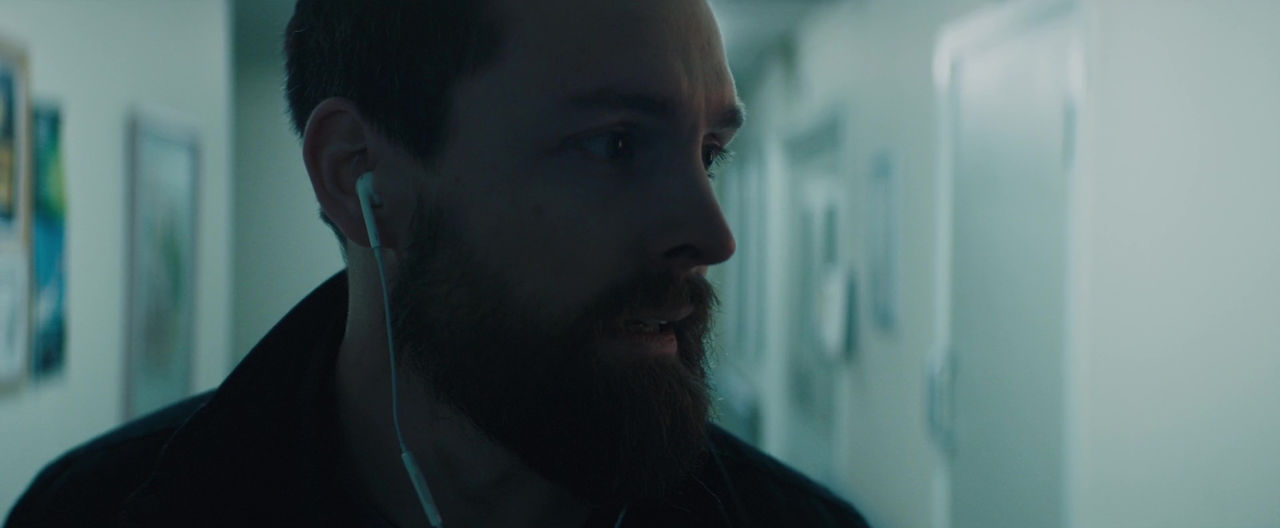
We have to talk about the audio - both Michelle Fairley's VO and the clever sound design. How long did it take to get that right and what was the process?
The tricky thing with this film is that the driving force behind everything the character does is entirely through his headphones and subsequently built in the sound design. This was both incredibly exciting to me, and the thing that worried me the most.
We shot the film with almost no sound. Just the couple of lines in the script and that was it. Everything else had to be done in post.
Elena had laid down a lot of guide work in the offline, but I knew that we would never be able to get close to how the film should feel until we got someone on board who was prepared to get a bit experimental.
That’s where Josh Campbell and Factory came in. We chatted a lot about how the sound needed to feel like it was coming from inside Ash’s head. The way things sound when you press your hands over your ears. The way you can feel the internal vibrations of your own body. This allowed us to be creative with using heart rate and breathing build momentum and create a sense of anxiety.
I had gone back and forth on whether to have a score, and what it should be.
It also meant we could sparingly jump out of the headphones to the real environment for moments of impact. It hopefully gives us that nice jump scare in the middle of the film. My only note to Josh on that was to make the sound so horrible that the audience wants to go back into the headphones. That Max’s dulcet tones should be a relief. Let them feel the way Ash does. Make them complicit.
I had gone back and forth on whether to have a score, and what it should be. Something somber, like the strings in Joker was an early thought, but with a score, VO and the need for something that set up the ‘self help tape’ jingle, it was starting to feel a bit messy. Using organic noises, Josh created his own score that was instantly recognisable as melodic self help synth music, but also blended in perfectly as an emotive accompanying underscore.
Casting Max, is probably where we saw the biggest divergence from mine and Hunter’s initial chats. Max had always been written with a very authoritative older males voice in mind, but on talking with Exec Producer Colm McCarthy, and the more I explored self-help guides, it struck me that the most beautifully honest and persuasive were often the female-led audiobooks and that completely changed how I saw Max.
I have always been a huge fan of Michelle’s. She has such a relatable and trusted quality in her voice. Her characters are so often caring and nurturing but hide a darkness below the surface, which was perfect. Not many people have that duality.
Lucky for us she was into the project and when the first lockdown lifted, she came in and recorded the VO for us in a couple of hours. It was one of the very last things we did and the last piece in the puzzle.

What's up next for you?
Through my role as EP at Partizan, I’m so very lucky to get to work every day with some incredible directors, and be so busy working on some fantastic commercial projects. That’s always been my number one focus, but having side projects where I can explore my own creativity is also a nice thing to be able to dip into too when I can carve out some personal time at the weekends.
Having side projects where I can explore my own creativity is also a nice thing to be able to dip into too when I can carve out some personal time at the weekends.
I have another short film in post at the moment and have written my first feature film that’s been developed with Warner Bros. That's scheduled to shoot in November with Partizan’s brilliant Matthias Hoene directing.
In what’s been a tough twelve months for everybody, I am so pleased to have exciting opportunities to look forward to this year.
)
